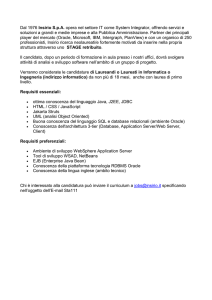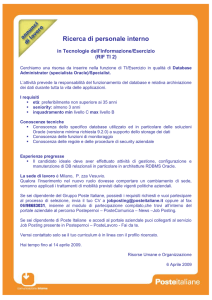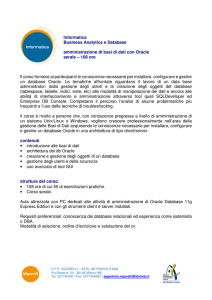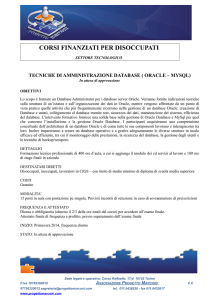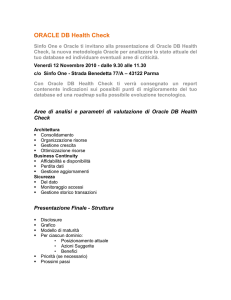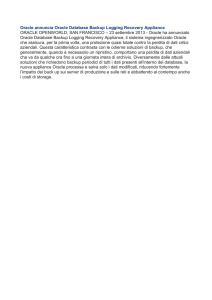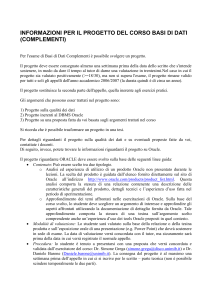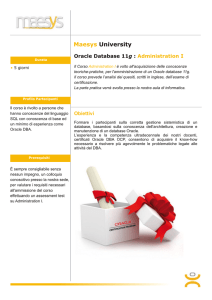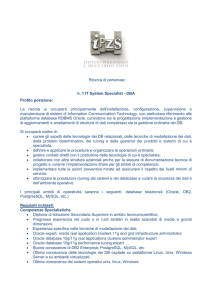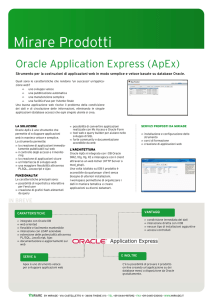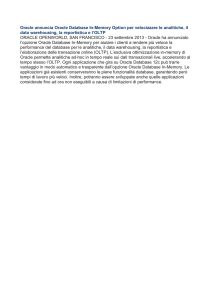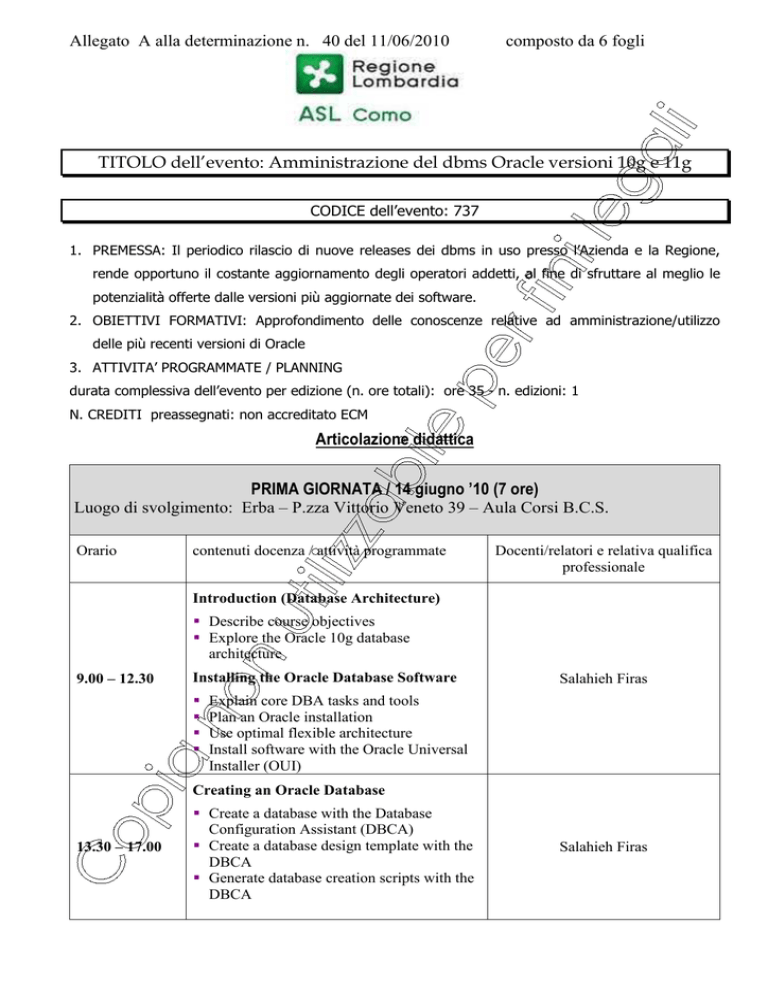
Allegato A alla determinazione n. 40 del 11/06/2010
composto da 6 fogli
TITOLO dell’evento: Amministrazione del dbms Oracle versioni 10g e 11g
CODICE dell’evento: 737
1. PREMESSA: Il periodico rilascio di nuove releases dei dbms in uso presso l’Azienda e la Regione,
rende opportuno il costante aggiornamento degli operatori addetti, al fine di sfruttare al meglio le
potenzialità offerte dalle versioni più aggiornate dei software.
2. OBIETTIVI FORMATIVI: Approfondimento delle conoscenze relative ad amministrazione/utilizzo
delle più recenti versioni di Oracle
3. ATTIVITA’ PROGRAMMATE / PLANNING
durata complessiva dell’evento per edizione (n. ore totali): ore 35 - n. edizioni: 1
N. CREDITI preassegnati: non accreditato ECM
Articolazione didattica
PRIMA GIORNATA / 14 giugno ’10 (7 ore)
Luogo di svolgimento: Erba – P.zza Vittorio Veneto 39 – Aula Corsi B.C.S.
Orario
contenuti docenza / attività programmate
Docenti/relatori e relativa qualifica
professionale
Introduction (Database Architecture)
Describe course objectives
Explore the Oracle 10g database
architecture
9.00 – 12.30
Installing the Oracle Database Software
Salahieh Firas
Explain core DBA tasks and tools
Plan an Oracle installation
Use optimal flexible architecture
Install software with the Oracle Universal
Installer (OUI)
Creating an Oracle Database
13.30 – 17.00
Create a database with the Database
Configuration Assistant (DBCA)
Create a database design template with the
DBCA
Generate database creation scripts with the
DBCA
Salahieh Firas
Managing the Oracle Instance
Start and stop the Oracle database and
components
Use Enterprise Manager (EM)
Access a database with SQL*Plus and
iSQL*Plus
Modify database initialization parameters
Understand the stages of database startup
View the Alert log
Use the Data Dictionary
SECONDA GIORNATA / 16 giugno ’10 (7 ore)
Luogo di svolgimento: Erba – P.zza Vittorio Veneto 39 – Aula Corsi B.C.S.
Orario
contenuti docenza / attività programmate
Docenti/relatori e relativa qualifica
professionale
Managing Database Storage Structures
9.00 – 12.30
Describe table data storage (in blocks)
Define the purpose of tablespaces and data
files
Understand and utilize Oracle Managed
Files (OMF)
Create and manage tablespaces
Obtain tablespace information
Describe the main concepts and
functionality of Automatic Storage
Management (ASM)
Administering User Security
Create and manage database user accounts
Authenticate users
Assign default storage areas (tablespaces)
Grant and revoke privileges
Ultima revisione
4 febbraio 2010
26 maggio 2009 aggiornamento ex DDG_2416/2009 Regione Lombardia
Salahieh Firas
Administering User Security
Create and manage roles
Create and manage profiles
Implement standard password security
features
Control resource usage by users
13.30 – 17.00
Managing Schema Objects
Salahieh Firas
Define schema objects and data types
Create and modify tables
Define constraints
View the columns and contents of a table
Create indexes, views and sequences
Explain the use of temporary tables
Use the Data Dictionary
Articolazione didattica
TERZA GIORNATA / 18 giugno ’10 (7 ore)
Luogo di svolgimento: Erba – P.zza Vittorio Veneto 39 – Aula Corsi B.C.S.
Orario
contenuti docenza / attività programmate
Docenti/relatori e relativa qualifica
professionale
Managing Data and Concurrency
9.00 – 12.30
Manage data through SQL
Identify and administer PL/SQL Objects
Describe triggers and triggering events
Monitor and resolve locking conflicts
Salahieh Firas
Managing Undo Data
Explain DML and undo data generation
Monitor and administer undo
Describe the difference between undo and
redo data
Managing Undo Data
Configure undo retention
Guarantee undo retention
Use the undo advisor
13.30 – 17.00
Configuring the Oracle Network
Environment
Use Enterprise Manager for configuring the
Oracle network environment
Create additional listeners
Create Net Service aliases
Ultima revisione
4 febbraio 2010
26 maggio 2009 aggiornamento ex DDG_2416/2009 Regione Lombardia
Salahieh Firas
Configure connect-time failover
Control the Oracle Net Listener
Test Oracle Net connectivity
Identify when to use shared versus
dedicated servers
QUARTA GIORNATA / 22 giugno ’10 (7 ore)
Luogo di svolgimento: Erba – P.zza Vittorio Veneto 39 – Aula Corsi B.C.S.
Orario
contenuti docenza / attività programmate
Docenti/relatori e relativa qualifica
professionale
Proactive Maintenance
9.00 – 12.30
Use statistics
Manage the Automatic Workload
Repository (AWR)
Use the Automatic Database Diagnostic
Monitor (ADDM)
Describe advisory framework
Set alert thresholds
Use server-generated alerts
Salahieh Firas
Performance Management
Use Enterprise Manager pages to monitor
performance
Use the SQL Tuning Advisor
Use the SQL Access Advisor
Use Automatic Shared Memory
Management
Performance Management
Use the Memory Advisor to size memory
buffers
Use performance related dynamic views
Troubleshoot invalid or unusable objects
13.30 – 17.00
Backup and Recovery Concepts
Identify the types of failure that may occur
in an Oracle Database
Describe ways to tune instance recovery
Identify the importance of checkpoints,
redo log files, and archived log files
Configure ARCHIVELOG mode
Ultima revisione
4 febbraio 2010
26 maggio 2009 aggiornamento ex DDG_2416/2009 Regione Lombardia
Salahieh Firas
QUINTA GIORNATA / 24 giugno ’10 (7 ore)
Luogo di svolgimento: Erba – P.zza Vittorio Veneto 39 – Aula Corsi B.C.S.
Orario
contenuti docenza / attività programmate
Docenti/relatori e relativa qualifica
professionale
Performing Database Backups
9.00 – 12.30
Create consistent database backups
Back your database up without shutting it
down
Create incremental backups
Automate database backups
Monitor the flash recovery area
Salahieh Firas
Performing Database Recovery
Recover from loss of a control file
Recover from loss of a redo log file
Perform complete recovery following the
loss of a data file
Moving Data
13.30 – 17.00
Describe available ways for moving data
Create and use directory objects
Use SQL*Loader to load data from a nonOracle database (or user files)
Explain the general architecture of Data
Pump
Use Data Pump Export and Import to move
data between Oracle databases
Use external tables to move data via
platform-independent files
Compilazione questionario di
apprendimento
Salahieh Firas
4. TIPOLOGIA EVENTO: Corso residenziale
5. METODOLOGIA (con indicazioni delle tecniche didattiche privilegiate): Per ogni argomento le lezioni
comprenderanno teoria ed esercitazioni pratiche
6. Indicazione nominativo Responsabile Scientifico: Ing. Luigi Moscatelli
7. Indicazione nominativo del TUTOR se previsto: non previsto
Ultima revisione
4 febbraio 2010
26 maggio 2009 aggiornamento ex DDG_2416/2009 Regione Lombardia
8. INDICAZIONE DESTINATARI DELLA FORMAZIONE (categorie profess./n. interni,esterni): n. 4
interni (1 programmatore e 3 collaboratori tecnici)
9. RIFERIMENTI SEGRETERIA ORGANIZZATIVA (risorse coinvolte, orari, modalità di iscrizione,
informazioni): Sig.ra Stefania Gallo – UO Gestione ICT – 031 370943
10. ATTESTATI: l’ attestato di frequenza sarà rilasciato a tutti coloro che:
- parteciperanno al 80% (quorum minimo 80%) rispetto al monte ore dell’evento formativo. Per
eventi di fsc limitati a 4 incontri di almeno 2 ore è obbligatoria la presenza del 100%;
- consegneranno il questionario di customer satisfaction, compilato;
- conseguiranno esito positivo di apprendimento
11. Modalità di rilevazione dell’apprendimento (specificare se questionario o altro e se pre test e post
test): questionario post test
12. Reazioni (somministrazione del questionario di “customer satisfaction”): utilizzo del questionario di
customer satisfaction
13. Evidenza (risultato organizzativo - indicatore descrittivo o numerico): Capacità di intervento sui
dbms Oracle – versioni 10g e 11g
NOTE
I CV dei docenti/relatori e degli eventuali tutor devono essere in formato europeo
I CV e le dichiarazioni di assenza conflitto di interesse dei docenti/relatori e degli eventuali tutor devono essere
conservate in forma cartacea presso la sede operativa del provider indicata nel campo anagrafica
Ultima revisione
4 febbraio 2010
26 maggio 2009 aggiornamento ex DDG_2416/2009 Regione Lombardia

